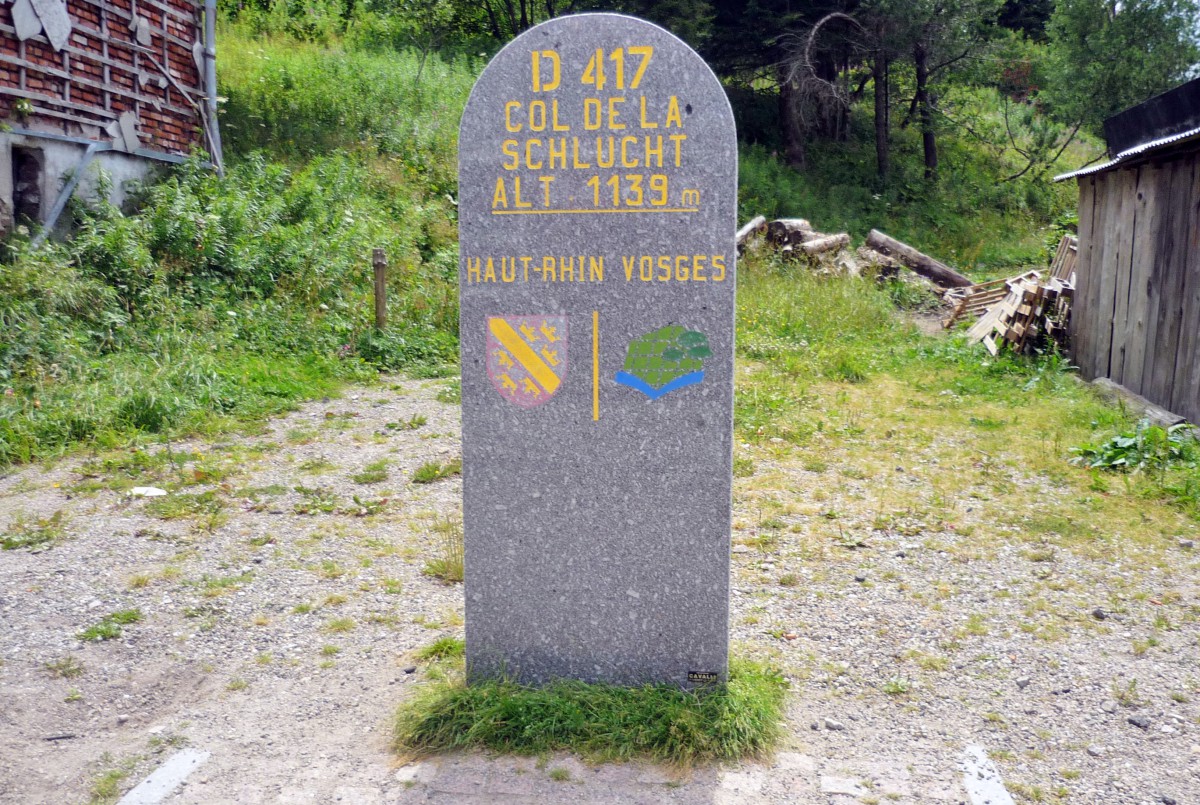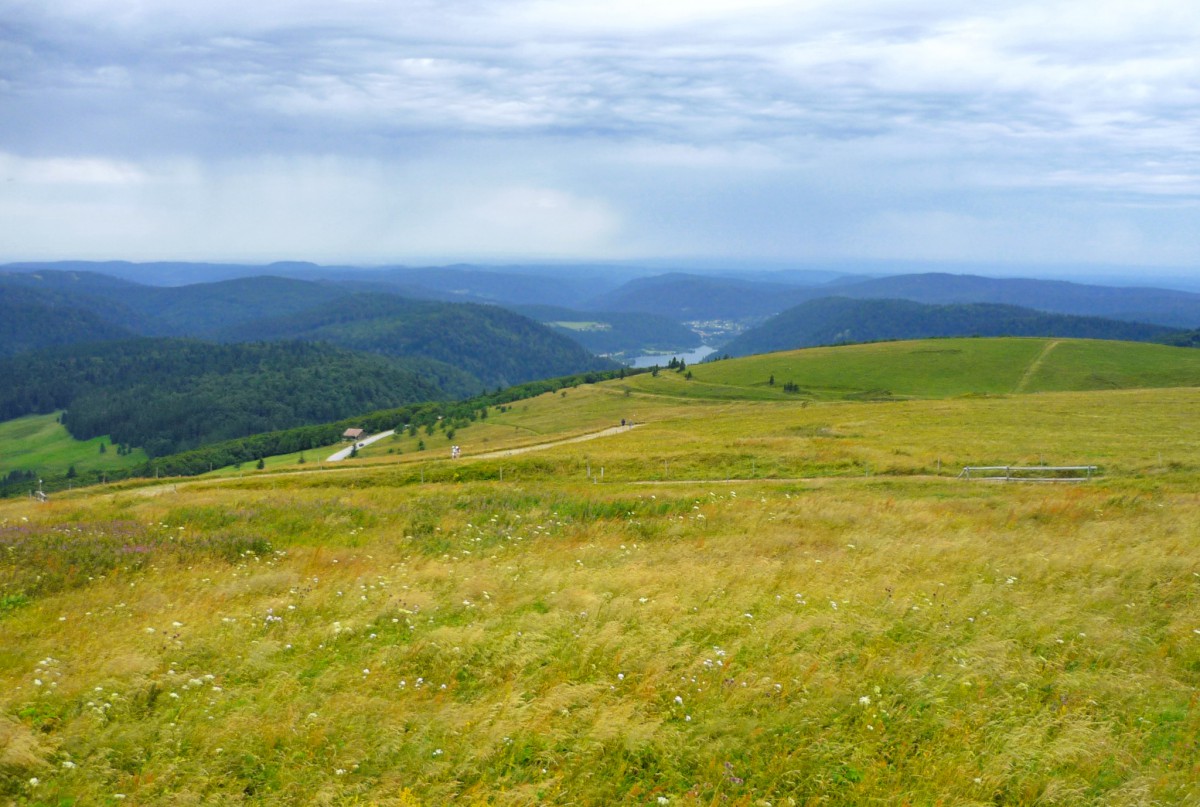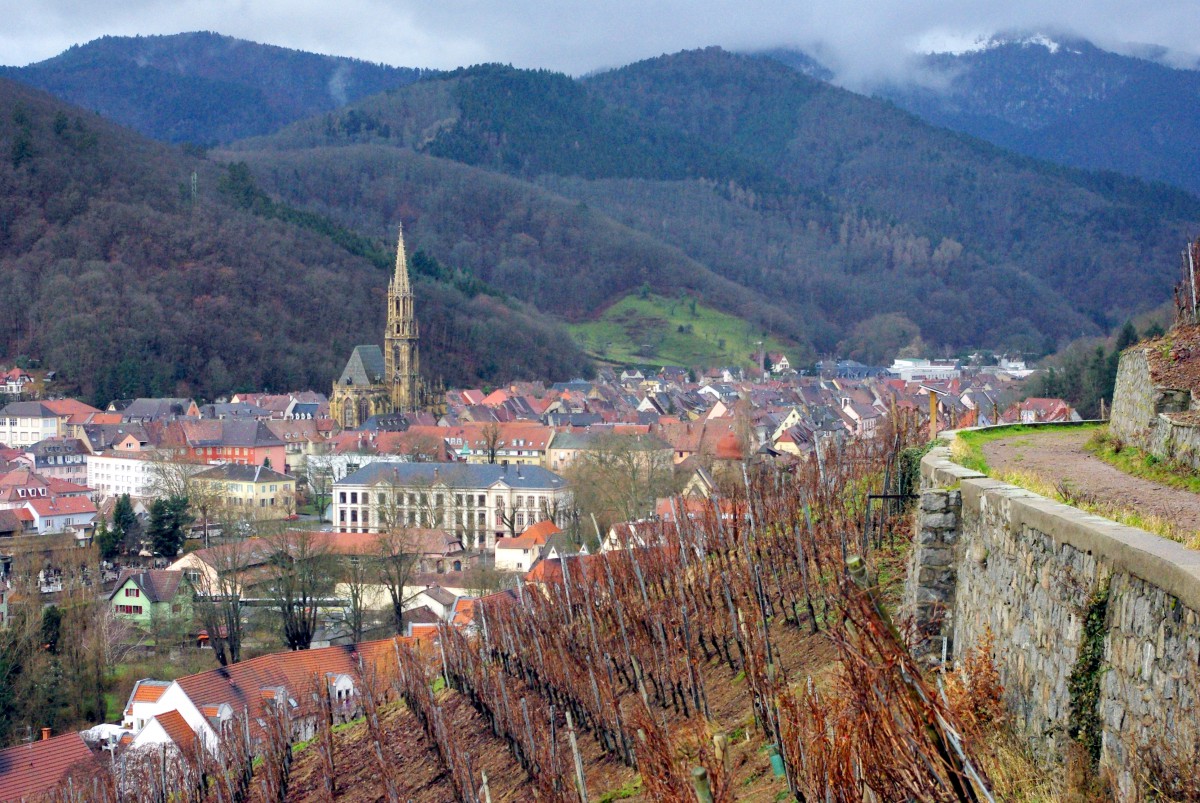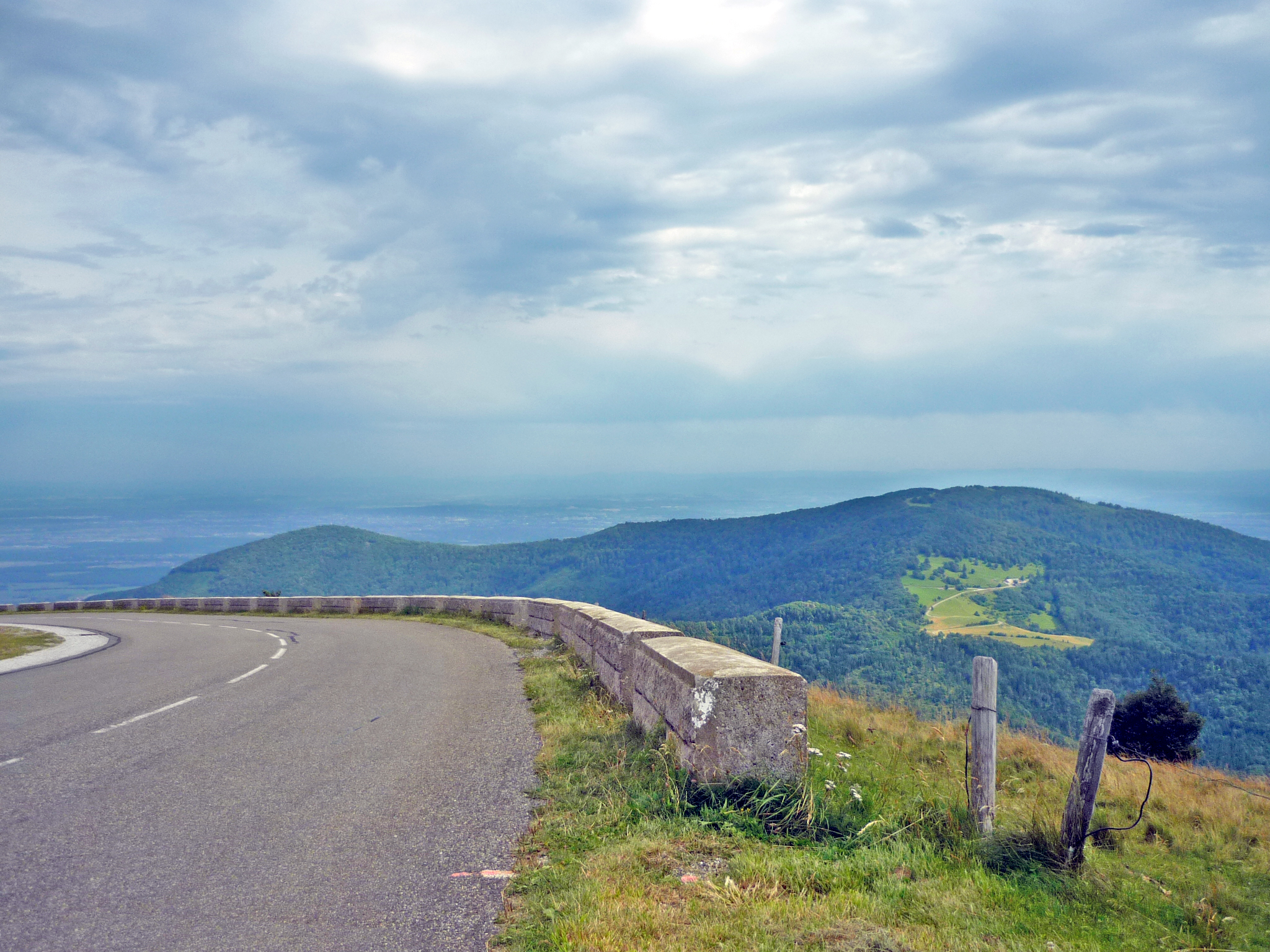Sublime countryside, panoramic views extending to the distant Alps and riding on the hills, the Route des Crêtes in the Vosges is following the example of the Route des Vins (the Alsace Wine Route), a reputed and highly frequented tourist itinerary during the summer period.
About the Route des Crêtes
The road follows a ridgeline route of 80km, linking the town of Thann to the Col de Bonhomme pass. Throughout its run, it is sometimes in Lorraine, and sometimes in Alsace. Symbolically, the Route des Crêtes marks the border between Lorraine and Alsace, between the Romance and Germanic language worlds.

At each mountainside, the road travels along bucolic countrysides, opening up views of mountain passes, rounded mountains, lakes, rocks, pastures, and forests of majestic pines.
On average, the road progresses to an altitude of 1,000 metres. There you discover plunging views of the Alsace Plain, which does not exceed 200 metres altitude. The highest point of the road (1,325m) is situated near the Vosges’ highest summit: the Grand Ballon (1,424m) and the lowest altitude is 825m at the Col Amic pass.
The Route des Crêtes was created fairly recently. Before becoming a tourist itinerary it was devoted to the military and strategic cause. It was during the First World War that the French High Command decided to create a road which would follow the ridge of the Vosges, thus allowing easier access to various Lorraine and Alsatian valleys on both sides of the Vosges. This project allowed for the faster movement of French military troops and their war material in the face of the German opponent.
The best means of discovering the countryside while following the Route des Crêtes is by hiking. And for those who do not wish to take their car, a shuttle operates on Sundays and public holidays from June to September on the Route des Crêtes and stops at several locations to let passengers hop on or off.
From the Col du Bonhomme to the Schlucht
Col du Bonhomme (949 m)
This mountain pass constitutes the northern departure point of the Route des Crêtes. It is only interesting for its geographic location: in fact, it was the obligatory crossing point for road transport between the Alsatian and Lorraine towns of Colmar and Nancy before the introduction of the Sainte-Marie-aux-Mines tunnel. Apart from some restaurants and hotels, the view on the Lorraine side is not very clear. The Alsatian side gives onto the Val d’Orbey, a curious little territory where the Alsatian dialect is traditionally not spoken, but rather a Romance language – Welche.
Col du Calvaire (1,134 m)
Upon arriving at this mountain pass, take care not to follow the road that goes back down into the Val d’Orbey. The road continues through forests and pastures.
The Gazon du Faing (1,303 m)
The first step of the journey is the Gazon du Faing, a vast, protected, grassy stretch. You’ll need to park your car in the restaurant’s parking area and climb by foot to the summit of the Gazon du Faing (45 mins, with a gentle slope). Arriving at the rocks, the panorama is quite simply superb.
The Alsace Plain is at your feet. On the horizon you can distinguish the blue line of the Black Forest in Germany and the most famous summits of the Vosges: the Hohneck (easily recognisable thanks to the form of the chalet situated at its peak), the Petit Ballon and the Grand Ballon. Below, the Lac des Truites (Trout Lake) glistens in the light of the morning sun.
From the Col de la Schlucht to the Hohneck
Col de la Schlucht (1,135 m)

Considered one of the Vosges’ great mountain passes along with those of Saverne and of Bussang, the Schlucht is a locality that is highly respected by the Alsatians and the Lorrainians who come here en mass during the summer period.
One of the reasons for this affection is that the Schlucht is situated on a major tourist axis, between Gérardmer in Lorraine and Munster in Alsace. The Meurthe, one of the great Lorraine Rivers, which crosses the towns of Saint-Dié-des-Vosges, Baccarat, Lunéville and Nancy, originates here. What’s more, we are in the middle of Munster Géromé – a famous cheese – territory.
In winter, the Schlucht is transformed into a ski station: its ski fields date back to the first skiing competitions in 1905 and now comprise 9 slopes/runs and 4 ski lifts.
Many restaurants welcome the incessant busloads of tourists visiting the mountain pass. The festive character of the mountain pass is sustained by a chair lift that is open during summer which takes you to the summit of Montabey, from where you can enjoy an effortless view! The return can be done by descending a summer toboggan run. Don’t forget to brake at the finish like the sign tells you, or else you will seriously risk hurtling down the slope to the bottom of the valley!
The Schlucht has often played host to the Tour de France, for example in 1992 and 2005, and then recently in 2009.
In the direction of Hohneck, the Route des Crêtes offers many viewpoints of the Lorraine side. Here you can see the expanse of Lake of Longemer and the pine forests of the valleys of La Bresse.
2km from the Schlucht, towards Hohneck, the Haut-Chitelet altitude garden (open in summer) extends across 11 hectares at an altitude of 1,228 metres. This remarkable botanical garden houses more than 2,500 species of cold region or mountainous plants of the world (some of which are from New Zealand) and belongs to the Conservatory and Botanical Gardens of Nancy (CJBN).
Follow the road until you reach a small restaurant which marks the Hohneck summit. From there, leave your car and continue on foot (1hr uphill) or drive along the little road leading to the summit.
The Hohneck (1,362 m)
One of the three emblematic summits of Vosges, along with the Grand Ballon and the Ballon d’Alsace, the Hohneck has the particularity of having a mountain hut at its summit, which is visible from a great distance away. The view there is exceptional. With the help of the viewpoint indicator, you can see all of the Vosges, from the Lorraine side to the Alsatian side, from the Donon to the north to the Grand Ballon to the south. The Alsace Plain and the town of Colmar are easily visible, as well as the Black Forest and the Jura. It is from this summit that on a clear day the Swiss Alps and Mont Blanc in Savoie will be visible from the next summits of the Vosges crossed by the Route des Crêtes. Just beware of the glacial wind that blows here even during summer!

From the Hohneck to the Grand-Ballon
From the Hohneck, follow the Route des Crêtes towards Markstein. The road continues on the west side, with views on the Blanchemer Lake and the Valley of the Vologne in Lorraine.
After 6km, near the summit of Rainkopf (1,304m), the Route des Crêtes permanently enters Alsace and stays there from here onwards.
Col du Herrenberg (1.191 m)
This pass located in Alsace allows us to admire a beautiful panorama of the Thur Valley and Kruth Lake. We dined on a local Marcaire dish in the neighbouring farmhouse B&B. The “marcaires” are the mountain farmers, breeders and cheese makers who have been looking after the summits of the Vosges since the 9th century. By clearing the summits’ forests, they created the unique-to-Vosges Hautes-Chaumes pastures for their cows. With tourism development, these farms have been transformed into “farmhouse B&Bs” which welcome visitors and walkers in addition to their farming activity.
Le Markstein (1,266 m)
Passing through Markstein in summer, there doesn’t seem to be any reason to stop here. And yet, the site is an active winter and summer sports station. The station was a stage of the Skiing World Cup in 1983 and 1987 and of the Paragliding World Cup in 1999.
The Grand Ballon (1,424 m)

The Grand Ballon is the highest summit in the Vosges. While the Hohneck is recognisable by the chalet atop its summit, the Grand Ballon instead features a futuristic structure built in 1997, which serves as a radar station for civil aviation.
The panorama is one of the widest in the Vosges; just don’t forget your binoculars! From the viewpoint indicator at the summit, in the foreground you can see the Alsace Plain and the towns of Mulhouse, Basel (Switzerland), and Colmar, then further in the distance the Black Forest and Jura. In the background, and with good weather conditions from October to May, you can distinguish a vast part of the chain of the Alps, from Austria to Savoy, passing by Liechtenstein, Switzerland (Bernese Alps) and the majestic Mont Blanc.

The Route des Crêtes bypasses the summit from the east, some 100 metres lower. You must continue on foot for 15 minutes to climb the summit.
Find out more about the Grand Ballon.
From the Grand-Ballon to Thann

From the Grand-Ballon, the Route continues down to the Vieil Armand and begins a part of its descent towards the Col Amic, offering remarkable views over the Alsace Plain.
The Col Amic (825 m)
This pass is not worth stopping at. It is however a crucial step for the cyclists who climb the Grand Ballon from the Alsace Plain. From the Col Amic, several roads join up to either the Alsace Plain, or the Thur Valley.
Located nearby are the old castle ruins of Freundstein, an isolated eagle’s nest at an altitude of 984m that holds the record of being the highest castle in Alsace.
The victim of an earthquake in 1356, of wars and of lightning strikes (1562), the castle was abandoned in the 16th century in favour of more comfortable dwellings on the plains. Its last use was to serve as an observatory for French soldiers during the First World War against the Germans positioned close by at the Vieil Armand. The poor castle suffered from new bombings at this time.
The Vieil Armand (906 m)
The final big step before arriving in the town of Thann on the plain, the Vieil Armand became a shrine to the memory of soldiers killed during the terrible confrontations of the First World War.
It was the French soldiers (the Poilus) who francized the Alsatian name of the mountain, the Hartmannswillerkopf, as “Vieil Armand”. The summit of the Vieil Armand overhangs the Alsace Plain by 956 metres, hence its strategic stake for control of the region.
This Verdun of Alsace endured its dark hours in 1915 when the Vieil Armand summit changed sides 4 times. The number of soldiers who died in the trenches of the mountain is unknown. It is estimated that 12,000 soldiers were killed in 1915 alone.
The national monument is erected above a crypt (admission fee payable) that contains the remains of 12,000 unknown soldiers. Behind it, the rows of the military cemetery of Silberloch count 1,260 tombs.
You then have to walk for about an hour to climb the Vieil Armand summit, where stands a 22m high white cross that is lit up at night and visible from the Alsace Plain. For those who are interested in the trenches of the First World War, several are visible near the summit, on both sides of the white cross.
The little town of Thann

A little more upbeat is the town of Thann, which must be visited before nightfall in order to be able to enter the Collégiale Saint-Thiébaut. The road from the Vieil Armand to the town of Cernay continues downhill into the forest thanks to several hairpin turns. Even if the Route des Crêtes officially ends in Cernay, it is recommended to continue along the road to the town of Thann. From there, you could drive back to Strasbourg through the Alsace Wine Route.
How to get to the Route des Crêtes
The Vosges mountains are easily accessible by car from Paris, Lyon, Strasbourg, Switzerland and Germany with the large network of motorways and routes départementales.
From Paris, take the N4 road (which is a dual carriageway from Vitry-le-François to Nancy), and then the express way from Nancy to Saint-Dié des Vosges.
If you travel from Australia or America you could take a flight to Paris Charles de Gaulle Airport and rent a car from there.
The TGV from Paris-Gare de l’Est takes just over 2 hours to Strasbourg, and also stops at the little town of Saint-Dié des Vosges.





What a great description of the road and the places of interest. A question for you: is the road suitable for a motor home? We are heading to France from NZ in a few weeks and might go this way around the end of February.
Thanks
Dan
Thank you Dan! Yes the road is suitable for a motor home. However long portions of the scenic route are closed until 1st May. Last time I took it in Winter, it was possible to reach Grand Ballon from Willer-sur-Thur (not from Uffholtz). Also accessible were the ski resorts of Col de la Schlucht and Le Markstein. But you won’t be able to drive all the way from the Col du Calvaire to the Grand Ballon… Have a great stay in France!!